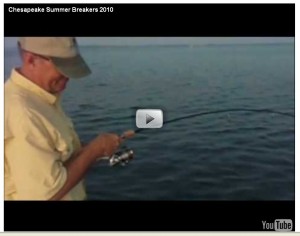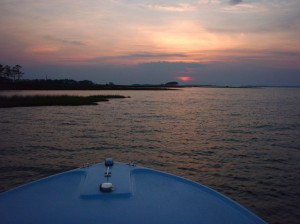 As the old saying goes, if we caught fish every time we went out, they’d call it catching instead of fishing. So, I guess my Friday evening/Saturday morning over-nighter to southern Maryland was a fishing trip, because there wasn’t a lot of catching involved. Striper fishing has been pretty good around the Bay Bridge and Poplar Island this week. We’ve been landing our share of mid-20 inch rockfish on light tackle with an occasional 30 incher mixed in, but I was hoping for more of a challenge. Friday afternoon, I launched out of Shipping Creek and pointed Thunder Road south though Poplar Narrows, past Sharp’s Island Light, around the Jame’s Island Horn and down past Hooperstown to the area just north of the Virginia Line that has been producing big red drum. It’s a 60 mile run – two hours in perfect conditions – but it took me a little longer. One reason is because I crossed the Bay for a visit with Mike at Buzz’s Marina, another reason is because I hit a pound net, but my biggest challenge was the wind. Here’s the story. Read More!
As the old saying goes, if we caught fish every time we went out, they’d call it catching instead of fishing. So, I guess my Friday evening/Saturday morning over-nighter to southern Maryland was a fishing trip, because there wasn’t a lot of catching involved. Striper fishing has been pretty good around the Bay Bridge and Poplar Island this week. We’ve been landing our share of mid-20 inch rockfish on light tackle with an occasional 30 incher mixed in, but I was hoping for more of a challenge. Friday afternoon, I launched out of Shipping Creek and pointed Thunder Road south though Poplar Narrows, past Sharp’s Island Light, around the Jame’s Island Horn and down past Hooperstown to the area just north of the Virginia Line that has been producing big red drum. It’s a 60 mile run – two hours in perfect conditions – but it took me a little longer. One reason is because I crossed the Bay for a visit with Mike at Buzz’s Marina, another reason is because I hit a pound net, but my biggest challenge was the wind. Here’s the story. Read More!
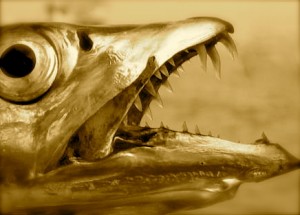 Friday morning we had an earthquake. It wasn’t a very big one, only 3.6 on the Richter Scale. I didn’t feel it, but apparently some of my fishing buddies found it unsettling. The epicenter was 3.1 miles underground near Gaithersburg. Earthquakes are very rare in Maryland. The last major one occurred in 1758. Some people reported it woke them up at 5:04 in the morning. Some even said it shook them out of bed. (Take it from someone who puts a lot of importance on sleep, that’s pretty unsettling.) The quake was also felt in Virginia, Pennsylvania and surrounding areas of Washington DC and Maryland. The event generated lots of curiosity and some panic among residents who aren’t used to feeling the earth move, but the only real consequence was a tsunami of bad jokes. Someone cracked that for the first time in years there was actually movement in congress. One of my Facebook friends posted a picture of the shockingly severe damage at her house. Read More!
Friday morning we had an earthquake. It wasn’t a very big one, only 3.6 on the Richter Scale. I didn’t feel it, but apparently some of my fishing buddies found it unsettling. The epicenter was 3.1 miles underground near Gaithersburg. Earthquakes are very rare in Maryland. The last major one occurred in 1758. Some people reported it woke them up at 5:04 in the morning. Some even said it shook them out of bed. (Take it from someone who puts a lot of importance on sleep, that’s pretty unsettling.) The quake was also felt in Virginia, Pennsylvania and surrounding areas of Washington DC and Maryland. The event generated lots of curiosity and some panic among residents who aren’t used to feeling the earth move, but the only real consequence was a tsunami of bad jokes. Someone cracked that for the first time in years there was actually movement in congress. One of my Facebook friends posted a picture of the shockingly severe damage at her house. Read More!
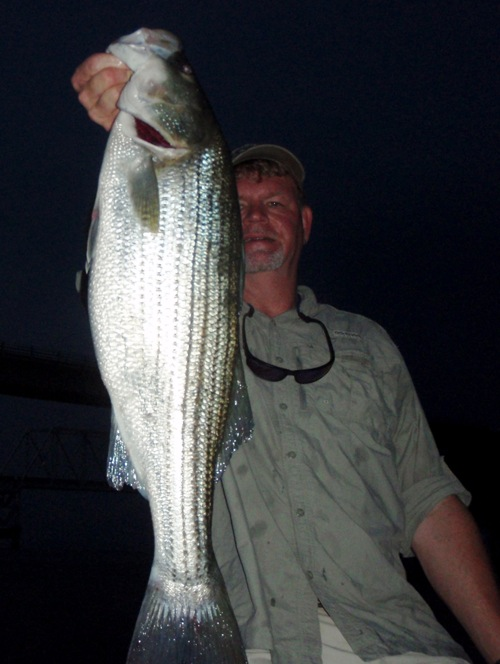 With Rhonda Vincent singing “Sweet Summertime” on the satellite radio, it was already 7:00 PM when I pulled into the Matapeake parking area. Due to a heavy work schedule, I didn’t think I’d get to fish at all tonight, but a welcome window of opportunity opened when rush hour traffic inexplicably parted like the Red Sea to reduce our usual commuting time by half . I took it as divine intervention. With lightning on the horizon, I launched Thunder Road into a ripping incoming tide pushed along by the two-day-old moon and a low pressure system to the south. Destination: Bay Bridge. It’s been three weeks since I’ve fished there. I wasn’t sure what patterns I might encounter, but I had a hunch the unsettled weather would turn-on the fish. I’ve been meaning to film some instructional video at the bridge for a while, and finally remembered to bring my cap cam. I started recording on my way to the ramp hoping my self-portraits wouldn’t turn out to be a study in unflattering camera angles (of course, they did).
With Rhonda Vincent singing “Sweet Summertime” on the satellite radio, it was already 7:00 PM when I pulled into the Matapeake parking area. Due to a heavy work schedule, I didn’t think I’d get to fish at all tonight, but a welcome window of opportunity opened when rush hour traffic inexplicably parted like the Red Sea to reduce our usual commuting time by half . I took it as divine intervention. With lightning on the horizon, I launched Thunder Road into a ripping incoming tide pushed along by the two-day-old moon and a low pressure system to the south. Destination: Bay Bridge. It’s been three weeks since I’ve fished there. I wasn’t sure what patterns I might encounter, but I had a hunch the unsettled weather would turn-on the fish. I’ve been meaning to film some instructional video at the bridge for a while, and finally remembered to bring my cap cam. I started recording on my way to the ramp hoping my self-portraits wouldn’t turn out to be a study in unflattering camera angles (of course, they did).
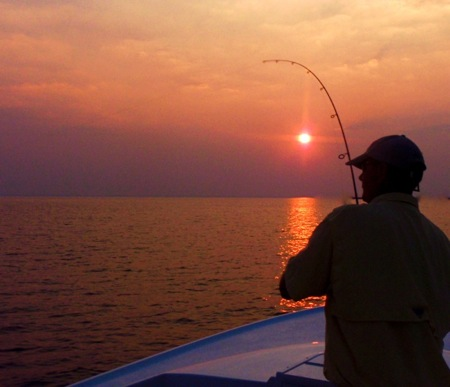 If you’re reading this website, chances are you pore over everything you can get your hands on about fishing in the Chesapeake Bay. If you’re like me, you have favorite authors and preferred books or periodicals, and you can’t wait for the next issue to come along. The work of one of my favorite Chesapeake writers can’t be found in newspaper columns or outdoor magazines, but I’ve read every fishing report he’s written since 2003. Keith Lockwood writes for Maryland’s Department of Natural Resources (DNR) fisheries website. I started reading his reports when I first started fishing the Bay. After recognizing the historical value of this weekly chronicle, I spent a couple of weeks scouring through all the archived entries. Through previous year’s dispatches I learned about angling techniques, behavioral patterns, places to fish, and a lot about the science behind our fishing regulations. I was extremely disappointed when I found out earlier this year that Keith would be cutting back on his weekly articles in favor of reader submitted entries in a section called The Maryland Angler’s Log. While I still miss Lockwood’s focused reports, I’ve been plesantly surprised by the new addition to the website. The Maryland Angler’s Log is a real winner. Read More!
If you’re reading this website, chances are you pore over everything you can get your hands on about fishing in the Chesapeake Bay. If you’re like me, you have favorite authors and preferred books or periodicals, and you can’t wait for the next issue to come along. The work of one of my favorite Chesapeake writers can’t be found in newspaper columns or outdoor magazines, but I’ve read every fishing report he’s written since 2003. Keith Lockwood writes for Maryland’s Department of Natural Resources (DNR) fisheries website. I started reading his reports when I first started fishing the Bay. After recognizing the historical value of this weekly chronicle, I spent a couple of weeks scouring through all the archived entries. Through previous year’s dispatches I learned about angling techniques, behavioral patterns, places to fish, and a lot about the science behind our fishing regulations. I was extremely disappointed when I found out earlier this year that Keith would be cutting back on his weekly articles in favor of reader submitted entries in a section called The Maryland Angler’s Log. While I still miss Lockwood’s focused reports, I’ve been plesantly surprised by the new addition to the website. The Maryland Angler’s Log is a real winner. Read More!
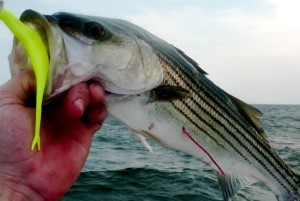 In a recent report I mentioned that I caught a tagged fish. It wasn’t the first fish with a tag I’ve caught on the Chesapeake – I’ve managed to land four previously – but it was the first time I felt like I knew exactly what to do. Despite my participation in conservation associations and advisory groups, it’s taken me four years to figure out how to properly handle a tagged fish caught in the Bay. Apparently I’m not alone because I’ve heard from some other experienced anglers who don’t fully understand the process either. The problem is, there are several organizations that are actively tagging fish, and the rules for each are somewhat different. For example, a pink tag on the left side belly of a striped bass is put there by the Department of the Interior’s Fish & Wildlife Service. I now know you can cut this tag off, measure, and release the fish. However, I hope you aren’t color blind because if that tag you cut off turns out to be chartreuse, you just disqualified yourself from the chance to win $25,000.00. It gets even more confusing. Read More!
In a recent report I mentioned that I caught a tagged fish. It wasn’t the first fish with a tag I’ve caught on the Chesapeake – I’ve managed to land four previously – but it was the first time I felt like I knew exactly what to do. Despite my participation in conservation associations and advisory groups, it’s taken me four years to figure out how to properly handle a tagged fish caught in the Bay. Apparently I’m not alone because I’ve heard from some other experienced anglers who don’t fully understand the process either. The problem is, there are several organizations that are actively tagging fish, and the rules for each are somewhat different. For example, a pink tag on the left side belly of a striped bass is put there by the Department of the Interior’s Fish & Wildlife Service. I now know you can cut this tag off, measure, and release the fish. However, I hope you aren’t color blind because if that tag you cut off turns out to be chartreuse, you just disqualified yourself from the chance to win $25,000.00. It gets even more confusing. Read More!



